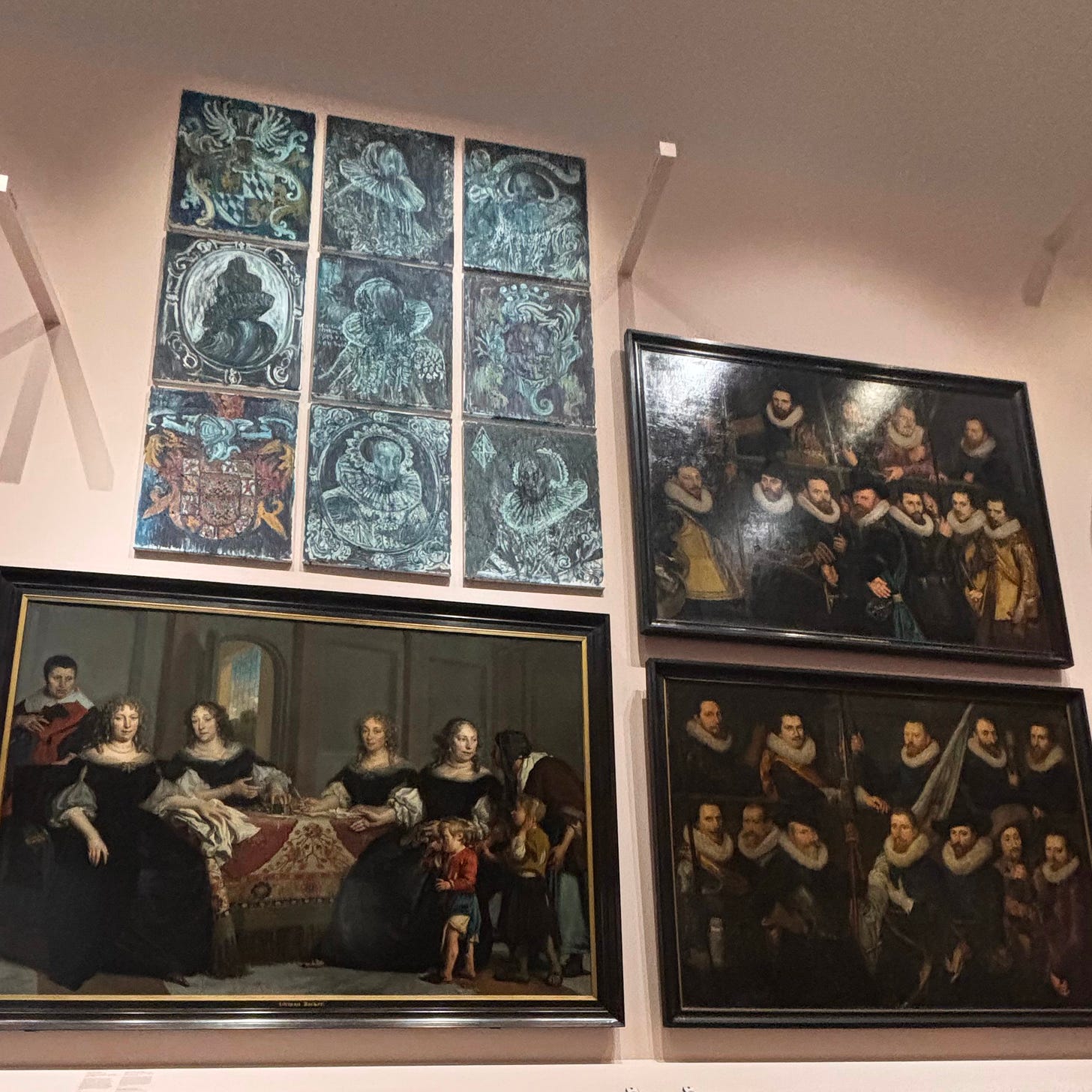There’s an exhibit on now at the Amsterdam Museum called Women of Amsterdam - an ode. It’s being put on in conjunction with the city’s 750-year anniversary and the idea is to recognize all the women who helped make Amsterdam the city it is today.
Conceptually, broadly, I think it’s interesting - enough so that of all the things I could visit during my four nights in Amsterdam this month, I went to this exhibit.
Two weeks later I’m still sitting with some discomfort about it.
First the good.

By far my favorite piece was a collection of nine paintings by Natasja Kensmil called Monuments of Regents. Kensmil speaks back to the huge 17th century Dutch paintings of groups of powerful men and women. It reminds the viewer the wealth that made those painting possible had dubious sources. It questions the symbols used to signal power and belonging. Each face in the painting is actually the accumulation of several faces, pointing to the fact that each person was every person and perhaps suggesting that the original painting were an attempt to preserve an individualism that didn’t exist - or existed in contrast with the anonymity of all the individuals that made their wealth possible.
Kensmil’s piece is part of the permanent collection and displayed along side some of the traditional paintings, I was in awe. Even better was the fact that the middle of the room (I think it used to be a chapel back when the building was a retirement home) is a two story volume, so viewers get to see the art frist from the ground and then from a second story position - which changes everything.
And yet.
As an ode to all women in Amsterdam, the exhibit went heavy on the all women part. It was a model of inclusion - but so much that I wonder whether all they did was dilute. I wonder if when we despair at women not being named in history, naming any woman who comes to mind is the answer. If you try to acknowledge the unnamed by naming all of them - are you changing anything?
Then there’s the part where the exhibit invites viewers to write their own odes to women (in Dutch). This is ostensibly cool - it’s interactive, you can honor your aunty, your mother, your neighbor, whoever.
Until I realize the exhibit includes some odes, that more odes are being collected on-line and turned into podcasts and, one day, a book. There are women writing about women. The writing work is a free contribution to what will become a product one day and is currently part of what attracts people to the museum and the exhibit. That the women today are essentially doing free work. That the museum is planning to use the work without any (as far as I can tell) compensation for these women. It smacks of “it’ll be good for your resume” jobs.
When I started going through a list of the names I saw, including some of the hundreds of odes online - another discovery. It turns out that numerous women who have written odes that are online have added the odes to their own online CVs. So… I write about my neighbor, that writing becomes material the museum can use and sell, and then I in turn add my contribution to my CV as evidence of my skills and experiences as a writer.
Looking on the English language site, I find this translation of Alex Kain’s ode to Jill Pattiradjawane. Before the text begins, I read, “This text was translated using AI and may contain errors. If you have suggestions or comments, please contact us at info.ode@amsterdammuseum.nl.” Given all the dangers of AI that writers and translators are talking about - and the fact that many people who are reading websites in other language are already using tools like Google translate to read websites in other language - why are they using a tool (unnamed) to translate this work and then asking readers to act as editors?
That is a very strange circle indeed and one I’m trying to think through.
So I’m curious - have any of you seen the exhibit in Amsterdam? What are your thoughts? How do we negotiate the tension between naming all the names and telling the stories of individuals?


I haven't seen the exhibit, but the way you untangle these layers is very compelling. The first multi-author anthology contract I ever saw, years ago, came to mind -- it was asking authors to donate their pieces in what seemed to me a rather roundabout way (plus pay out-of-pocket for editing, to an editor of the publisher's choosing). The museum exhibit's section at the link talks about FAQ, but I couldn't find those, so I headed to the T&C (https://www.amsterdammuseum.nl/en/topic/women-of-amsterdam/terms-and-conditions) and to the submission form, up to the upload part, which I'm assuming is the last. (That all-fuchsia background!) The T&C seem to cover all kinds of products I can think of at this hour, but I can't figure out if by granting permission to the museum to use the piece, the author retains any rights to the piece. Something under point 9 ("In many cases, Amsterdam Museum does not own the copyrights (or other intellectual property rights) to the material published online.") suggests that they do, but things are still not as clearly stated as they could (welp, should) be...